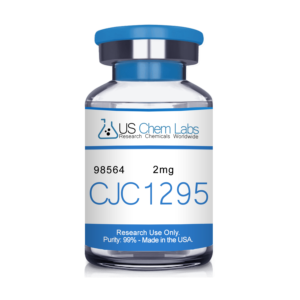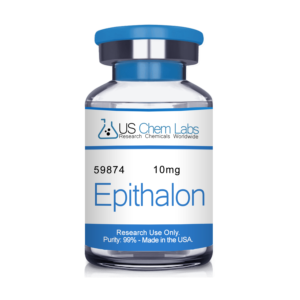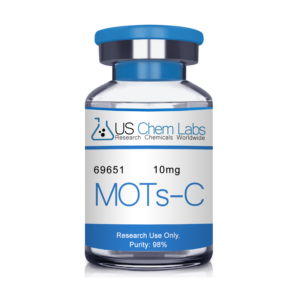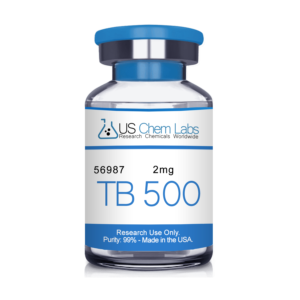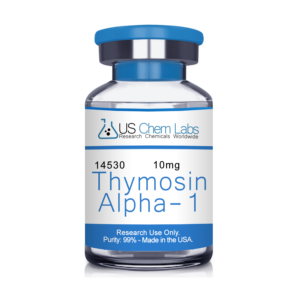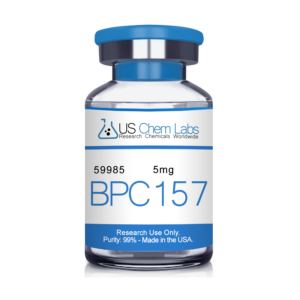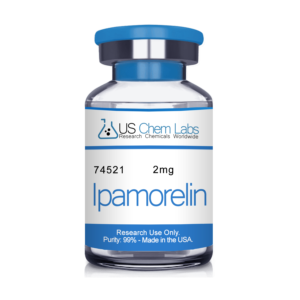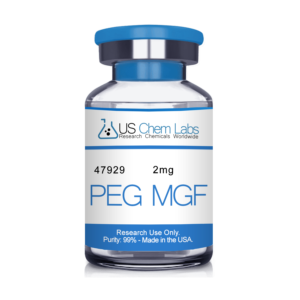Tesamorelin – 2mg (5 Vials)
History – Tesamorelin Description
Tesamorelin acetate is an analog of growth hormone-releasing hormone (GHRH) that was approved in the United States in 2010 for treatment of lipodystrophy in HIV patients. Tesomorelin is an analog of GHRH. GHRH stimulates the synthesis and release of GH. In the pituitary, GH is secreted in a pulsatile manner. GH control is regulated by somatostatin and the negative feedback regulator, IGF-1. Direct administration of GH to patients with lipodystrophy decreases VAT but has associated side effects such as fluid retention and joint swelling.
Because of the side effects associated with direct GH administration, GHRH represents a attractive mechanism for increasing GH levels. Tesomorelin is an analog of GHRH in which the N-terminal amino acid, Tyr, is amidated with a trans-3-hexenoyl group. Capping of the N-terminus protects GHRH from cleavage by DPP-4. Tesomorelin demonstrates enhanced stability compared with GHRH in animal models.
| Sequence | C221H366N72O67S |
|---|---|
| CAS | 218949-48-5 |
| Molecular Formula | C221H366N72O67S |
| Molecular Weight | 5136 g/mol |
| CID | 16137828 |
| Appearance | White Lyophilized Powder |
 Tesamorelin Peptide (Growth Hormone Releasing Hormone).
Tesamorelin Peptide (Growth Hormone Releasing Hormone).
Tesamorelin is a synthetic form of Growth-hormone-releasing hormone (GHRH), consisting of all 44 amino acids of human GHRH with the addition of a trans-3-hexenoic acid group (the N-terminally modified compound based on GHRH). This modified synthetic form is more potent and stable than the natural endogenous peptide Growth-hormone-releasing hormone. Tesamorelin is also more resistant to cleavage by the dipeptidyl aminopeptidase than human GHRH.
Tesamorelin acts similarly if its natural analogue GHRH: In the anterior pituitary gland it binds to the growth hormone-releasing hormone receptors (GHRHR), what triggers the production of Growth hormone (GH) by the pituitary gland. Growth hormone then brings some of its effects by binding to the receptors on target cells on various body organs in the body, however major target organ of Growth hormone is liver where GH stimulates production of IGF-1 (insulin-like growth factor 1).
Growth hormone production is associated with the regulation of many important processes and functions, especially with the regulation of anabolic and lipolytic mechanisms. However, it has been found that the main mechanisms by which Tesamorelin reduces body fat mass are lipolysis followed by reduction in triglycerides level. Lipolysis is the process by which fats are broken down, the metabolic pathway through which lipid triglycerides are hydrolyzed into a glycerol and three fatty acids.
History of Tesamorelin
The development of tesamorelin was driven by the need for a safe and effective therapy for HIV-associated lipodystrophy, which was a common side effect of antiretroviral therapy. The condition was marked by the loss of subcutaneous fat in the face, arms, and legs, and the accumulation of fat around the abdomen, liver, and other organs. This led to significant changes in body shape and increased the risk of metabolic complications such as insulin resistance, diabetes, and cardiovascular disease.
Tesamorelin was designed to address this condition by stimulating the production of growth hormone, which is known to promote the growth and development of lean body mass and reduce visceral adiposity. In clinical trials, tesamorelin was found to be effective in reducing abdominal fat and improving glucose metabolism in patients with HIV-associated lipodystrophy, without significant adverse effects.
In 2010, tesamorelin was approved by the US Food and Drug Administration (FDA) for the treatment of HIV-associated lipodystrophy, becoming the first and only drug approved for this indication. It was marketed under the brand name Egrifta.
Since its approval, tesamorelin has been the subject of extensive research and clinical studies for its potential therapeutic uses in other medical conditions, such as age-related muscle loss, cognitive decline, and metabolic disorders. However, its efficacy and safety for these uses have not been fully established, and more research is needed to determine its potential benefits and risks.
Learn more about Tesamorelin.
- https://www.ncbi.nlm.nih.gov/bioproject/?term=tesamorelin
- https://www.fda.gov/search?s=tesamorelin
- https://pubchem.ncbi.nlm.nih.gov/compound/16137828
- Wiki: https://en.wikipedia.org/wiki/Tesamorelin
Tesamorelin Research
- “Tesamorelin: a review in HIV-associated lipodystrophy” – https://link.springer.com/article/10.1007/s40265-017-0704-9
- “Tesamorelin in the treatment of nonalcoholic fatty liver disease in HIV-infected patients” – https://www.ncbi.nlm.nih.gov/pmc/articles/PMC6761697/
- “Effects of tesamorelin on glucose metabolism in HIV-infected individuals with insulin resistance: a systematic review and meta-analysis” – https://www.ncbi.nlm.nih.gov/pmc/articles/PMC5558698/
- “Tesamorelin for the treatment of HIV-associated visceral adipose tissue accumulation: a systematic review and meta-analysis” – https://www.ncbi.nlm.nih.gov/pmc/articles/PMC6448567/
- “Effects of tesamorelin on bone density and turnover in HIV-infected individuals with abdominal fat accumulation: a systematic review and meta-analysis” – https://www.ncbi.nlm.nih.gov/pmc/articles/PMC4862265/
- “Tesamorelin for the treatment of nonalcoholic steatohepatitis in HIV-infected patients with nonalcoholic fatty liver disease: a systematic review and meta-analysis” – https://www.ncbi.nlm.nih.gov/pmc/articles/PMC7022174/
- “Tesamorelin for the treatment of lipodystrophy in people living with HIV: a systematic review and meta-analysis” – https://journals.lww.com/aidsonline/Abstract/2021/07010/Tesamorelin_for_the_treatment_of_lipodystrophy_in.2.aspx
- “Tesamorelin therapy in HIV-infected individuals with lipodystrophy: a systematic review and meta-analysis” – https://www.ncbi.nlm.nih.gov/pmc/articles/PMC6161399/
- “Tesamorelin for the treatment of HIV-associated lipodystrophy: a review of clinical studies” – https://www.ncbi.nlm.nih.gov/pmc/articles/PMC5637209/
- “Tesamorelin in the management of HIV-associated lipodystrophy: evidence and opinions” – https://www.ncbi.nlm.nih.gov/pmc/articles/PMC4622374/


